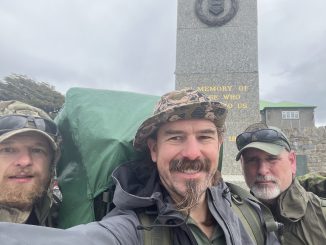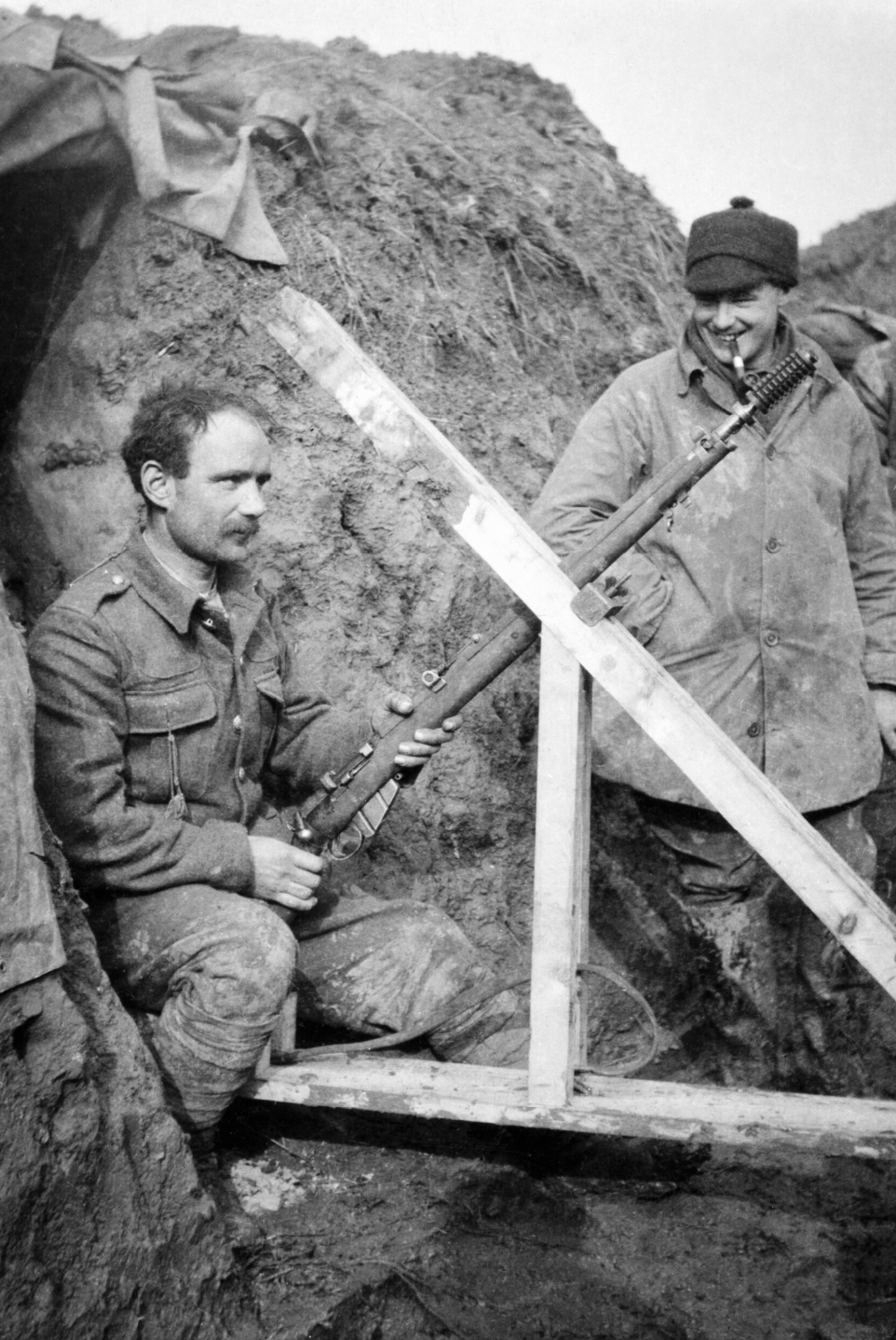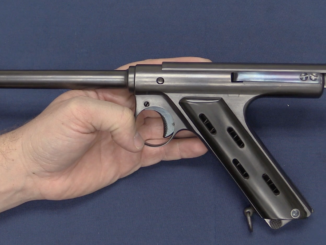When the British began developing a shortened version of the No4 Lee Enfield in 1943 (which would become the No5 MkI “Jungle Carbine”), the development process included work with some rather older rifles. What we have here is a 1922 production No1 MkV rifle cut down as a trials prototype for the carbine development program. The No1 MkV was a trials gun itself from the early 1920s which basically gave a rear aperture sight to the classic MkIII SMLE. Unfortunately, I don’t have any specific details on the testing or use of this particular example, but I think it is a fascinating example!
Related Articles

Forgotten History
In the Footsteps of 45 Commando: 60 Miles Across the Falklands
Want a patch or t-shirt with our adorably heavily armed rockhopper penguin? Both are available from Varusteleka: https://www.varusteleka.com/en/search?q=penguin I was recently joined my friends Les Winner (Polaris Worldwide Logistics) and Jari Laine (Varusteleka) for an […]

Artillery
Vintage Saturday: Rifle Grenade
2nd Lieutenant L. J. Barley of the 1st Battalion, Cameronians (Scottish Rifles), watching as a rifle grenade is prepared for firing from trenches at Grande Flamengrie Farm on the Bois Grenier sector of the line […]

Prototype
Maxim Silverman Model 1896 Automatic Pistol (Video)
Hiram Maxim is obviously best known for the Maxim Machine Gun, but he and (most significantly) his assistant Louis Silverman also dabbled in handgun design. It appears that the work was primarily Silverman’s, done with […]

Why are so frequently subtitles in vietnamese. ??
1 I presume the barrel was cut down to create a carbine
2. That would result in a lower muzzle velocity
3. A lower MV would mean the sight needed to be altered
So, was the sight rebuilt…
Have always wanted to take an early No 4, cut the slot & stock, drill the pin hole, and install a magazine cutoff, making an ersatz Mk 6.
Bearing in mind the ‘wandering zero’ issue that allegedly stopped the No.5 being more widely adopted in post war service, I wonder if this was due to the lightening cuts in the receiver causing inconsistency. Perhaps the many ‘Jungle Carbine’ fakes based on cut down no.4s are actually better shooting rifles, at the expense of a few extra ounces in weight.
The Ishapore etc rifles are either made on standard receivers, or converted from standard rifles. They do not have the infamous lightening cuts.
I have one of the Ishapor “jungle carbines”.
Don’t know who modified the gun since I have read that there were no Islamorada jungle carbines.
I only paid 100$ and wouldn’t sell it for a thousand even if it’s not worth near that.
7.62 reloads I have been able to hold 5 inch consistent groups. I have not seen wandering 0 but the sights are marginal at best.
The wandering 0, how much did it change? inches or feet?
I did a quick internet search using ‘jungle carbine wandering zero’ and got a fair number of hits. It might just be an urban myth, however there is a plausible opinion that some rifles from Fazakerley were poorly made, especially with the stock bedding, and that only the ‘good ones’ have survived. Unfortunately my actual shooting experience was limited, with only about 50 rounds in the early 80s at short range, good fun, but the rubber butt pad was solid and useless and smaller than the normal plate.
So perhaps our “wandering zero” isn’t a design flaw but a manufacturing error, potentially combined with environmental interference like moisture getting into the wood?
I really need to carry out a proper test of my two No5’s and see if the Shirley and Fazakerly versions differ in accuracy.
Both are 1945’s. Fortunately I have sufficient Mk 7 ball ammunition.
I have a 1922 NoI MkV* carbine. Made in Enfield, but converted to 20″ barrel at RFI (India) in 1943. Not Jungle Carbine in style, but genuine conversion with full length forearm and handguard with matching # nosecap. MkV rear sight on receiver.
Hi Ian what bolt action battle rifle do you suggest is the best of WW1 / WW2.
Many thanks
He’s repeatedly stated his personal preference for the M197 Enfield rifle in .30-06, I believe. 🙂
Yes, an excellent British design.
I have two. One got the RFI treatment in India, but it is an original No 5.
As mentioned above, the rubber buttpad is rock hard and smaller than the footprint of the entire butt. They should have just put a metal cap on the regular butt.
Other than that, it’s a very handy and light carbine. I am sure the British army would have been totally fine with it as their general issue rifle for WWII. However, after that, bolt actions were obsolete as primary infantry weapons. It was too late.
I’ve never tried any precision shooting with it. I can hit a 1gal plastic milk jug at 100m most of the time so…that’s pretty ok right?
Something Ian seems to have decided to “save for later.”
I’ll tell it now. Moreover, this directly concerns the accuracy of the English rifles of the Second World War.
A significant part of the rifles were made with barrels having 2 grooves instead of 5.
These barrels, known as “military ersatz”, were practically no different from ordinary barrels in use. POSSIBLE except for slightly worse accuracy when using a boat-tail bullets.
But, since everyone considered such barrels to be “military ersatz”, some not too conscientious traders gave such barrels for “revision to a normal look”, adding “missing” 2 grooves.
Of course, no marks were put.
Such barrels can be easily distinguished by the number of grooves less than on the original.
And, of course, the accuracy of such “modified” barrels can come close to the original only by accident.